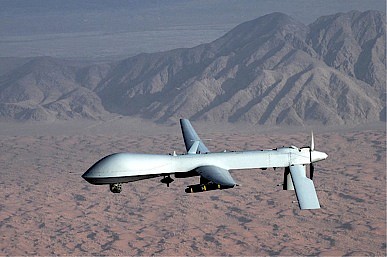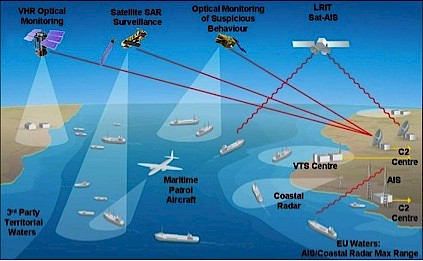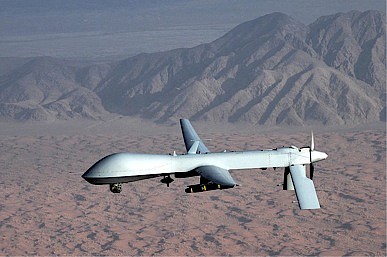Remote control
12 December 2014, Utrecht, NL
—
US Air Force airman operating RQ-1 Predator unmanned
vehicle
Photo credit: US Air Force
Remote control: A brief introduction
Upon entering the main hall, the audience is greeted by a remote-controlled mini-drone hovering above the speaker’s podium. While the stormy Dutch weather has caused a few grumpy faces amongst the audience, this very direct introduction to a rather theoretically oriented conference immediately spikes the enthusiasm amongst the audience, a mix of students, academics, and journalists. A first glance at the program, filled with its many ‘techno-political’ titles of keynote speeches and panel sessions, affirms that it will be both an exciting and long day. While the drone keeps humming above the audience, the organizers of the day, Rosi Braidotti and Jolle Demmers, open the conference with a short but strong message:
Taking as its central theme the increasing use of new surveillance technologies as a means of governance and warfare, the conference explores intersecting issues of violence, containment, and technology unfolding as highly complex sociopolitical and scientific phenomena. The current techno-cultural developments pose a challenging task to all critical academics in the humanities and beyond, and the audience is invited to participate in discussions and to think along with the speakers. In the panels, attention will be paid to the following questions:
‘What analytical vocabularies help us to conceptualize these phenomena?’
‘How is legitimacy communicated and performed?’
‘How is remote control and surveillance resisted and countered by those who are subjected to it?’[note 1]
Remoteness and recoupment
In front of a packed audience, the first speaker of the day, Mark Duffield (University of Bristol, UK) introduces his keynote speech as a work-in-progress for his upcoming book. According to Duffield, the two opposing terms of ‘remoteness’ and ‘recoupment’ have taken center stage in recent developments in conflict management. He notes that an increasing existential distancing from violence and poverty is taking place, leading to the physical abandonment of war zones and places of austerity. At the same time, technological innovations are being put into place to recoup this loss. Duffield’s research on humanitarian emergencies has led him to conclude that the withdrawal of humanitarian assistance on the ground is driven by uncertainty and risk aversion, which advance the creation of fortified compounds from which aid and interventions are coordinated and analyzed. He notes the rapid digitalization of humanitarianism in the past decade, giving as an example the United Nations’ High Commission for Refugees, which now uses a system of biometrical registration for refugees in order to establish identities, which is shared through a common database across borders.
While Duffield jumps from ‘cyber affirmationism’ to ‘crisis informatics’, and concludes with a ‘genealogy of logistics’, it becomes clear that his general analysis includes both the negative and productive aspects of remoteness as consequence of global neoliberalism. His central argument concerning the rise of crisis as a means to manage and mediate conflicts and violence is inspired by a Marxist critique of capitalism, with a slightly teleological undertone. According to Duffield, even though technology provides a ‘workaround’ for real problems, it leaves in place the actual problems of inequality and austerity created by capitalism. The transformation of violence, suffering, and risk into calculated and socially transmitted information systems is actually leading, he maintains, to a deceleration of conflict resolution. Because of its existential distancing, the use of technology ultimately advances violent clashes on the ground. In short, the remote management of crisis is incapable of producing working interventions.
Security governance
After a quick coffee break that wakes up the last sleepy-looking guests, the panel session on security governance is opened.[note 2] Marieke de Goede and Gavin Sullivan(University of Amsterdam, NL)start the panel by presenting their research on a politically loaded issue: security and kill lists. These lists, such as the White House’s ‘kill list’ and ‘no-fly lists’, appear to be straightforward instrumental security devices: a list with names of people who pose a threat to national security. But de Goede and Sullivan note that such lists do not simply document threats: they produce threat objects. For example, the criteria used to classify people as ‘terrorists’ do not preexist, but are written and mediated through security lists. A terrorist becomes a terrorist through an antiterrorist list. From this perspective, it seems necessary look at the agency of lists: ‘how does the list device really work’?
Sullivan, a practicing lawyer defending ‘blacklisted’ subjects, and de Goede, a researcher on counterterrorism, continue their presentation in a very technical but highly informative fashion. According to them, the central difficulty with understanding lists is that lists are preemptive, which means that the criteria for being on a list are in constant flux according to newly emerging threats. Further complexity is added by the fact that lists and profiles are informed by a vast number of national and international databases. For example, European Intelligence, the National Security Agency, the Central Intelligence Agency, and a growing number of private actors are producing the information used for profiling. This information is fed into various databases, such as the Terrorist Screening Database, which then is combined with biometrical information and other lists like the Specially Designated Global Terrorist List. Fragmentary information about people is shared between security agencies, culminating in the creation, rearrangement, and the reinterpretation of profiles. In short, many national and international databases and lists are mingling, leading to newly emerging complexities in the practice of profiling. Once someone has a profile, this profile gets a life of its own, making it almost impossible for it to be erased. For these reasons, Sullivan and de Goede call for critiques that make visible the diffuse conditions through which security lists acquire a life of their own.
The next speaker is Beatrice de Graaf, professor of History of International Relations & Global Governance (Utrecht University, NL). While the heads and eyes of a few students drop upon hearing the word ‘history’, de Graaf’s approach to the study of lists actually touches on a crucial element that had been absent in the previous presentation: the genealogy of the list. According to de Graaf, in the fifteenth century lists functioned as records of rights and entitlements. The centralized administration system, as we know it today, was the result of Napoleonic times and the introduction of the military draft. De Graaf notes that even though policing, registration practices, and identity checks to prevent espionage have been around since the late eighteenth century, these practices have recently undergone a fundamental epistemic shift. While the lists of the nineteenth and early twentieth centuries documented and kept records on real people, the security lists from the post-9/11 era are increasingly compiled based on the ‘what’, not the ‘who’–not who the person is, but what this person might be. This means that today’s security regime responds in a preemptive manner to profiles, not people, which leads to an objectification of identity. For example, does person X wear a turban? How far away is person X located from a compound where criminal activity is suspected to be taking place? In how far does the shape of person X’s baggage correspond to the shape of a rifle? Such questions are crucial for classifying a person as ‘terrorist’. They generate measurements that function as probabilistic devices for calculating the potential risk that a profile of a person, not the person himself, poses.
In response to questions from the audience concerning the juridical legitimacy of decisions based on a profile, de Graaf notes several issues arising from the separation of the real person and her profile. First, the decisions taken based on a profile might decide the life of a person. Profiles target people who cannot be targeted by the traditional juridical system, in which a person is innocent until proven guilty. Second, profiles do not know reciprocity. While an accused person should be able to defend herself against accusations, risk calculations and final judgments are imposed upon a profile that cannot speak back.
The last speaker of this panel session on security governance, Stephanie Simon (University of Amsterdam, NL), shifts the focus of the panel towards another highly explosive issue of post-9/11 politics, namely migration control and border management. In the spirit of the talk by Sullivan and de Goede, Simon presents a technical description of the ‘border-surveillance device’ and its workings.
Simon explains that an epistemic shift in border surveillance has taken place (similar to that noted by de Graaf in connection to lists). Before the incorporation of high-tech pre-frontier surveillance, Europe relied heavily on the distribution of expert security reports from its borders and abroad in order to come up with migration-management strategies. With private companies such as FRONTEX entering the market of border control after 9/11, the calculations of geospatial surveillance technologies and advanced communication systems are increasingly becoming part of EU efforts to know its borders. With this, the traditional classification of ‘the border’ as a geopolitical divide gets blurred, and spatial dimensions become all encompassing. As an example, Simon comments on satellite pictures of possible tire tracks in the Saharan desert that are analyzed by computers as possible evidence for migratory patterns: ‘amusing, but sadly real’.
‘Integrated maritime surveillance’
Photo
credit:
European Space Agency (ESA)
Simon uses the theme of ‘being on the cusp’ to describe the necessity of knowing at any given moment what is happening on the frontier, and anticipating what is likely to be happening there in the near future. Key words such as ‘preparedness’ or ‘responsiveness’ are exemplary of this new high-tech situational awareness that promises immediate coordinated responses and produces databases filled with geovisual data and maps. Current efforts in technological progress are mainly directed at adding vitality to the traditional static-ness of maps. Since migration is a dynamic phenomenon, interactive maps will increasingly try to correspond to the dynamics of reality.
Despite this slightly disturbing development towards a ‘Big Brother’ scenario, with her final remark Simon points to the enormous gap between the envisioned possibilities arising from the use of surveillance technologies and their workings in real life applications. Having conducted extensive on-site research, she assures the audience that technology often does not do what it is intended to do. This is due to both technical malfunctions and the human factor.
With this last message, the listeners are sent off to lunch. After three hours of cutting-edge research presentations on rapidly changing technologies and epistemic shifts, it is almost surprising to find that the weather outside in the real world has remained exactly the same: windy and wet.
Drones
MQ1 Predator unmanned aircraft
Photo credit:
US Air Force/Lt Col Leslie Pratt)
As Stephen Graham of Newcastle University (UK) had to cancel his presentation, the conference organizers quickly filled this program gap with the recently screened film Drone (2014), by Tonje H. Schei. This difficult-to-digest documentary about the CIA drone war in Waziristan juxtaposes the experiences and daily realities of drone pilots who kill with people on the ground whose families have been killed. Throughout the screening, the audience remains fully absorbed in the soundless video footage of armed drone strikes, drawn into the silence within drone control stations that lie far away from the actual war, and the speechlessness of traumatized pilots who fail to talk about the numbers of (innocent) people they have killed. The film produces many shaking heads in reaction to the macabre contrast between images of leading politicians defending the use of drones as ‘humane’ warfare; career fairs organized by the army, where young kids are recruited to be future pilots with highly advanced warfare games; and pictures of torn bodies, crying children, and protesting people on the ground. Overall, Drone is received as a quite devastating documentary.
The film also raises two other interesting points worth a short comment. First, it brings into picture the concept of ‘militainment’. War games are increasingly being developed by the US Department of Defense in collaboration with psychologists in order to recruit and create skilled drone pilots. Games function as educational tools that invade the daily lives of youngsters, thereby bringing violence, in the form of digital warfare, into close proximity with people. This is a countereffect of the distancing from the usual physical engagement in warfare. The concept of militainment shows that, as Mark Duffield noted in his introductory keynote, remoteness and proximity are mutually intertwined processes. Second, Drone points to problems of transparency and accountability. Remote-controlled killing is executed in secrecy and in the absence of a clear juridical framework. While no judges are involved in deciding upon life or death, various institutions, from the United States’ president, the NSA, the CIA, all the way to the US Air Force, are involved in the killing process. The question of legal accountability becomes therefore a highly complex issue, making a juridical response to the drone war very difficult.
More drone talk
In the last panel session of the day, titled ‘Drones’, the issues of transparency and accountability are elaborated on in more detail. As a trained political scientist and F-16 pilot, speaker Professor Commodore Frans Osinga (Dutch Defense Academy), is ‘far from impressed’ by the previous film on drones. Identifying as a ‘just war theorist’, he calls for a nonbiased analysis of the pros and cons of the use of armed drones in warfare. According to him, the public should not overestimate the deployment of this technology since only 1 percent of all drones are currently being used for armed attacks. Most drones have either an exploratory or a support function for interventions on the ground. Still, his experiences working as a high-ranked military official who advises the Dutch army on such issues show that there are several technical arguments made against unmanned drone attacks.
First of all, drones can easily violate national sovereignty, a current issue in Pakistan. The Pakistani government has declared drone strikes a military invasion of national airspace, and has therefore legally committed to attacking future drones in defense of their national population. Then, since drone strikes are legally justified as acts of counterterrorism, they fall under the jurisdiction of the police, not the military. But as the US Air Force is actively involved in making drone killings possible, drone strikes may legally be interpreted as acts of war. Further, even though statistics on this matter are not yet available, drone strikes are often considered counterproductive to the fight against terrorism because they produce anti-Western sentiments amongst local populations. Last, drones undermine the original logics of warfare, since their deployment leads to a loss of reciprocity. Traditionally, killing meant that a soldier exposed his own life to the possibility of death, a possibility eliminated by remote-controlled warfare.
More and more advisors, however, are being employed by the military to find ways to legalize drone killings and statistically assess the real impact of drones. One must not forget that wars are fought by choice, not by necessity, which means that risk mitigation will always be a central concern of war strategists. Drones present an interesting, but not yet perfected tool to reduce human casualties and give a more ‘humane’ face to warfare.
Osinga’s last comment about the need to ‘humanize’ warfare is provoking, especially to the academics in the audience who are working on a critical analysis of humanitarianism. ‘At the end of the day’, Braidotti concludes, ‘the whole discussion on drones is about humanity. But where are the posthumanists in this room?’
Indeed, can we imagine critical assessments of new technologies in warfare and national security that do not revolve around the humanistic ideals that we believe define us so much as human beings?
Manuel Raab
Anthropology of Health, Care and the Body,
University of Amsterdam
Endnotes
1 Back
http://news.hum.uu.nl/events/conference-remote-control-violencecontainmenttechnology-2/, accessed 21 January 2015
2 Back
This panel took place simultaneously with a panel entitled ‘Remote Monitoring and the Art of Building Peace and Resisting Containment,’ which is not included in this report.


